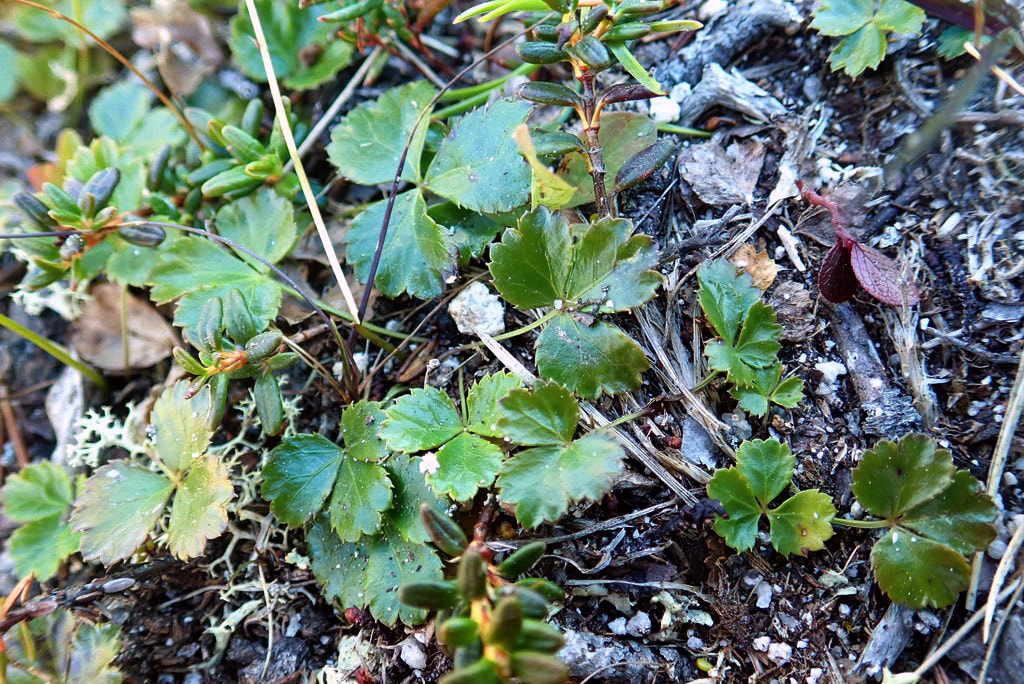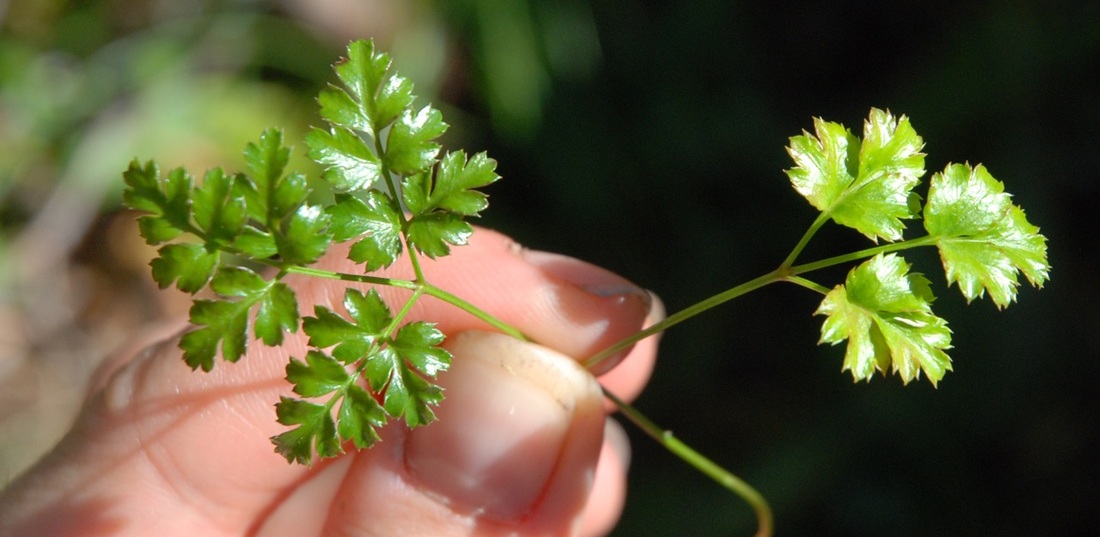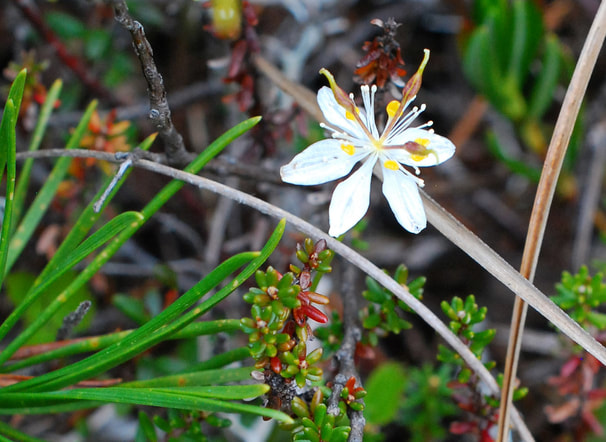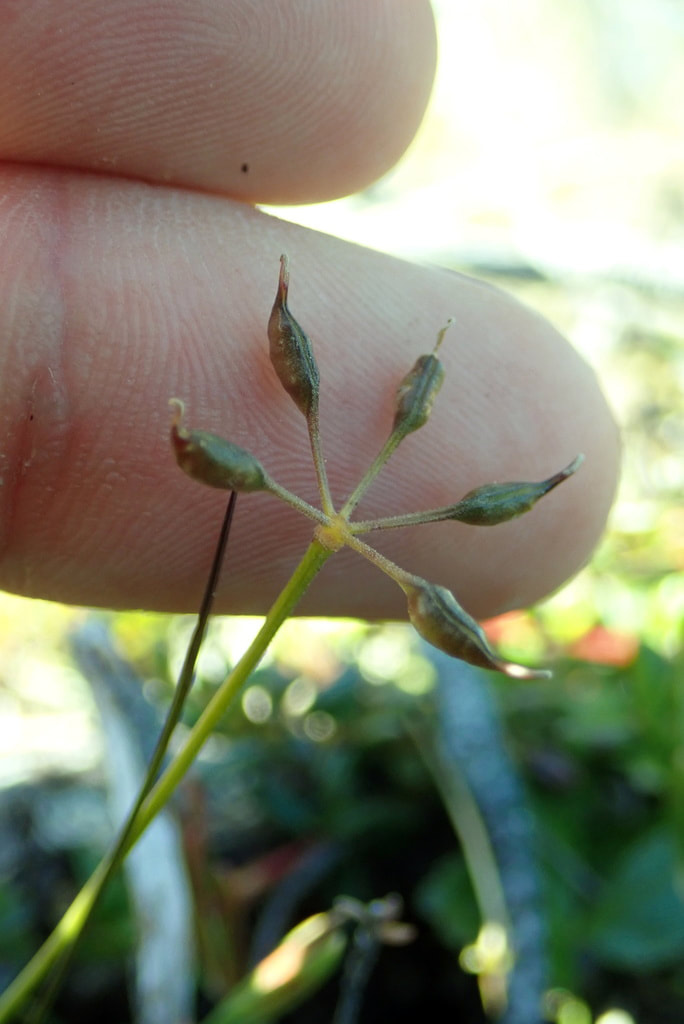Three-leaved goldthread, threeleaf • Coptis trifolia
{Goldthread = a reference to the golden colour of the thread-like rhizomes; Coptis from kopto = to cut, referring to the divided leaves; trifoliata = 'having three leaves'}
Three-leaved goldthread growing among mosses, lichens, and low-lying shrubs in Calvert Island bogs. Clockwise from bottom left: a comparison between fern-leaved goldthread (left) and three-leaved goldthread (right). Bottom right: seed pods. Photos by Andrew Simon (top left, bottom right) and Kelly Fretwell.
Identification
This evergreen perennial species belongs to the buttercup family and grows 3-12 cm tall from yellow to orange rhizomes. Its basal leaves are divided into three egg-shaped leaflets with toothed margins and shallow lobes. The leaflets may be short-stalked (as in the comparison photo at bottom left) or unstalked (as in the other photos). The leaflets are 1-2 cm long. The solitary flowers are whitish and fleshy. The seeds occur in beaked pod structures (follicles).
Habitat & Range
Three-leaved goldthread grows in wet forests, bogs, and seepage areas from low to middle elevations. In BC it is common west of the Coast-Cascade Mountains and more rare eastward, though it is found across much of Canada and into the northern United States (see map). Its coastal range extends north to Alaska. It is also found in Siberia and Japan.
Similar Species
Three-leaved goldthread is less common than fern-leaved goldthread (Coptis asplenifolia), which has fern-like leaves that are more divided and lobed than those of the former. The flowers have a very different appearance as well: the long sepals flare backwards and give the flower an overall shape similar to that of a shooting star.
Human Uses
This bitter-tasting plant has medicinal uses in some North American First Nations. Roots were traditionally used to treat a variety of illnesses in babies and children, and rhizomes were used for gastrointestinal illnesses as well as an array of other illnesses.
Intriguing Info
Three-leaved goldthread contains berberine, an alkaloid with anti-inflammatory, antibacterial, astringent, anticonvulsant, immunostimulant, and sedative properties.
iNaturalist
https://www.inaturalist.org/taxa/126251-Coptis-trifolia
This evergreen perennial species belongs to the buttercup family and grows 3-12 cm tall from yellow to orange rhizomes. Its basal leaves are divided into three egg-shaped leaflets with toothed margins and shallow lobes. The leaflets may be short-stalked (as in the comparison photo at bottom left) or unstalked (as in the other photos). The leaflets are 1-2 cm long. The solitary flowers are whitish and fleshy. The seeds occur in beaked pod structures (follicles).
Habitat & Range
Three-leaved goldthread grows in wet forests, bogs, and seepage areas from low to middle elevations. In BC it is common west of the Coast-Cascade Mountains and more rare eastward, though it is found across much of Canada and into the northern United States (see map). Its coastal range extends north to Alaska. It is also found in Siberia and Japan.
Similar Species
Three-leaved goldthread is less common than fern-leaved goldthread (Coptis asplenifolia), which has fern-like leaves that are more divided and lobed than those of the former. The flowers have a very different appearance as well: the long sepals flare backwards and give the flower an overall shape similar to that of a shooting star.
Human Uses
This bitter-tasting plant has medicinal uses in some North American First Nations. Roots were traditionally used to treat a variety of illnesses in babies and children, and rhizomes were used for gastrointestinal illnesses as well as an array of other illnesses.
Intriguing Info
Three-leaved goldthread contains berberine, an alkaloid with anti-inflammatory, antibacterial, astringent, anticonvulsant, immunostimulant, and sedative properties.
iNaturalist
https://www.inaturalist.org/taxa/126251-Coptis-trifolia
References
Coptis trifolia (L.) Salisb. In Klinkenberg, Brian. (Ed.). E-Flora BC: Electronic Atlas of the Plants of British Columbia. Lab for Advanced Spatial Analysis, Department of Geography, University of British Columbia, Vancouver. Accessed 04/11/2014.
Mackinnon, A. et. al. Edible & Medicinal Plants of Canada. Vancouver, BC: Lone Pine Publishing. P. 252.
Pojar, J. and MacKinnon, A. (1994). Plants of Coastal British Columbia. Vancouver, BC: Lone Pine Publishing. P. 252.
Authors and editors of page
Kelly Fretwell and Brian Starzomski (2014).
Coptis trifolia (L.) Salisb. In Klinkenberg, Brian. (Ed.). E-Flora BC: Electronic Atlas of the Plants of British Columbia. Lab for Advanced Spatial Analysis, Department of Geography, University of British Columbia, Vancouver. Accessed 04/11/2014.
Mackinnon, A. et. al. Edible & Medicinal Plants of Canada. Vancouver, BC: Lone Pine Publishing. P. 252.
Pojar, J. and MacKinnon, A. (1994). Plants of Coastal British Columbia. Vancouver, BC: Lone Pine Publishing. P. 252.
Authors and editors of page
Kelly Fretwell and Brian Starzomski (2014).








